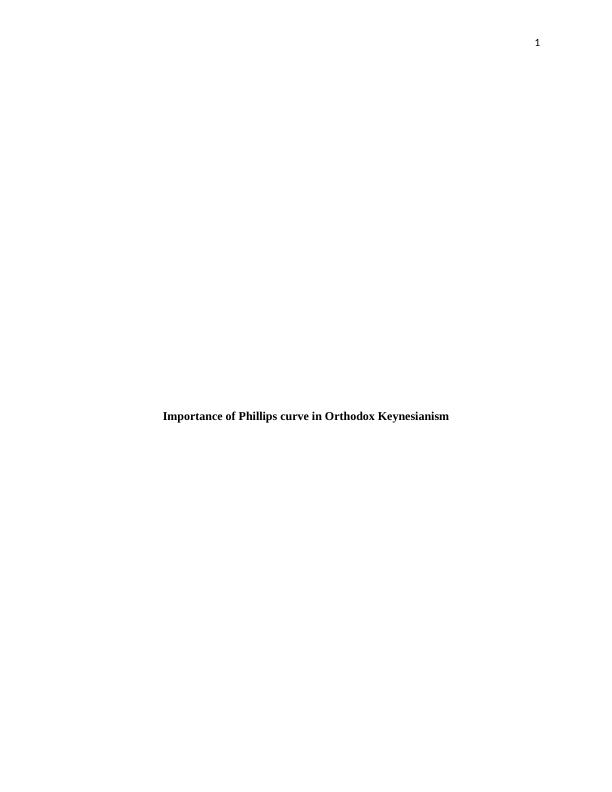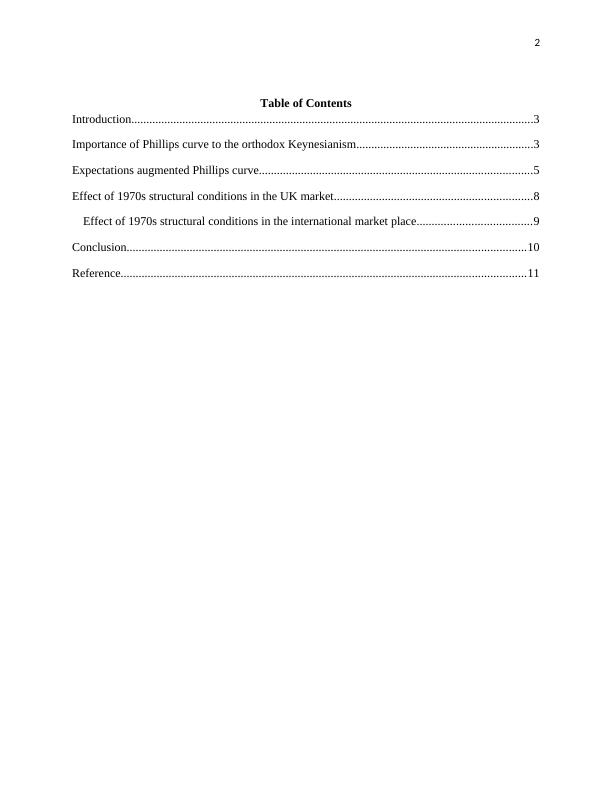Importance of Phillips curve in Orthodox Keynesianism
Added on 2023-04-21
13 Pages3802 Words285 Views
1
Importance of Phillips curve in Orthodox Keynesianism
Importance of Phillips curve in Orthodox Keynesianism

2
Table of Contents
Introduction......................................................................................................................................3
Importance of Phillips curve to the orthodox Keynesianism...........................................................3
Expectations augmented Phillips curve...........................................................................................5
Effect of 1970s structural conditions in the UK market..................................................................8
Effect of 1970s structural conditions in the international market place......................................9
Conclusion.....................................................................................................................................10
Reference.......................................................................................................................................11
Table of Contents
Introduction......................................................................................................................................3
Importance of Phillips curve to the orthodox Keynesianism...........................................................3
Expectations augmented Phillips curve...........................................................................................5
Effect of 1970s structural conditions in the UK market..................................................................8
Effect of 1970s structural conditions in the international market place......................................9
Conclusion.....................................................................................................................................10
Reference.......................................................................................................................................11

3
Introduction
A Phillips curve shows the inverse relationship between the unemployment rate and the rate of
inflation in an economy. According to Colander (1995), it can make an association between the
nominal variables such as the price level, the wage rate, the inflation rate and between the other
components of the real economy. More specifically, it can be stated that the Phillips curve can
derive the changes of nominal income and how it would decompose the changing of quantities as
well as the price level of the goods. Therefore, in terms of economics, the nature of Phillips
curve can determine the reflection of the interaction of demand and supply on the economy and
how it would affect the real and the nominal variables of the economy, so that the policymakers
would also be affected. Before discussing the importance of Phillips in the orthodox economy, it
is necessary to describe the discovery behind its origin.
Importance of Phillips curve to the orthodox Keynesianism
In the opinion of Forder (2010), A. W. Phillips, the economist of the London School of
Economics, had discovered the concept of this curve in the year 1950, while he was engaging
with the Keynesian analytical framework. As per the Keynesian theory, during the period of
recession, the inflationary pressure is much lower. However, if the output of the economy would
start to push the potential GDP, then the economy would face greater challenges. During this
period, Phillips found that the inflation rate of a country is inversely related with the rate of
unemployment of the country. In this context, he collected 60 years information of the UK and
hence, his propounded theory is referred as Phillips curve and has started to describe in the
Keynesian economy.
Introduction
A Phillips curve shows the inverse relationship between the unemployment rate and the rate of
inflation in an economy. According to Colander (1995), it can make an association between the
nominal variables such as the price level, the wage rate, the inflation rate and between the other
components of the real economy. More specifically, it can be stated that the Phillips curve can
derive the changes of nominal income and how it would decompose the changing of quantities as
well as the price level of the goods. Therefore, in terms of economics, the nature of Phillips
curve can determine the reflection of the interaction of demand and supply on the economy and
how it would affect the real and the nominal variables of the economy, so that the policymakers
would also be affected. Before discussing the importance of Phillips in the orthodox economy, it
is necessary to describe the discovery behind its origin.
Importance of Phillips curve to the orthodox Keynesianism
In the opinion of Forder (2010), A. W. Phillips, the economist of the London School of
Economics, had discovered the concept of this curve in the year 1950, while he was engaging
with the Keynesian analytical framework. As per the Keynesian theory, during the period of
recession, the inflationary pressure is much lower. However, if the output of the economy would
start to push the potential GDP, then the economy would face greater challenges. During this
period, Phillips found that the inflation rate of a country is inversely related with the rate of
unemployment of the country. In this context, he collected 60 years information of the UK and
hence, his propounded theory is referred as Phillips curve and has started to describe in the
Keynesian economy.

4
Figure 1: Phillips curve
(Source: Glyn, 2006)
In the opinion of Palley (2005), derivation of the typical aggregate supply curve is associated
with Phillips curve. However, during the period of great depression, the period during the year
1929- 1932, the classical view on the Phillips curve had changed. When the policymakers would
start to exploit the adverse relationship among the unemployment and the inflation rate, then
under the fiscal policy and monetary policy, the Phillips curve would be move up or move down.
As per the concept of classical economics, real output is dependent upon the supply side
economy, which in turn rely upon several factor of production and these are labour, capital and
the productivity. Therefore, with the changes of demand for the products would directly affect
the price level and also the inflation rate. However, Helleiner (1994) argued that in the classical
economy, the Phillips curve would not be able to describe the relationship between the rate of
unemployment and the change of the money wage rate. Apart from this, in the orthodox
Keynesianism, the concept of classical dichotomy as well as the monetary neutrality would not
be hold with the changing of money supply and also with the shifting of nominal demand.
Furthermore, monetary policy would not have real effect in the orthodox Keynesian period. In
this context, Coibion and Gorodnichenko (2015) stated that the effect of monetary policy on the
money supply would affect the demand and hence, the price level would be changed. This was
the reason, why both the concept of monetary neutrality and classical dichotomy would be
abolished in the neo-classical period.
Figure 1: Phillips curve
(Source: Glyn, 2006)
In the opinion of Palley (2005), derivation of the typical aggregate supply curve is associated
with Phillips curve. However, during the period of great depression, the period during the year
1929- 1932, the classical view on the Phillips curve had changed. When the policymakers would
start to exploit the adverse relationship among the unemployment and the inflation rate, then
under the fiscal policy and monetary policy, the Phillips curve would be move up or move down.
As per the concept of classical economics, real output is dependent upon the supply side
economy, which in turn rely upon several factor of production and these are labour, capital and
the productivity. Therefore, with the changes of demand for the products would directly affect
the price level and also the inflation rate. However, Helleiner (1994) argued that in the classical
economy, the Phillips curve would not be able to describe the relationship between the rate of
unemployment and the change of the money wage rate. Apart from this, in the orthodox
Keynesianism, the concept of classical dichotomy as well as the monetary neutrality would not
be hold with the changing of money supply and also with the shifting of nominal demand.
Furthermore, monetary policy would not have real effect in the orthodox Keynesian period. In
this context, Coibion and Gorodnichenko (2015) stated that the effect of monetary policy on the
money supply would affect the demand and hence, the price level would be changed. This was
the reason, why both the concept of monetary neutrality and classical dichotomy would be
abolished in the neo-classical period.

End of preview
Want to access all the pages? Upload your documents or become a member.
Related Documents
ECO202 Macroeconomics Assignmentlg...
|9
|1333
|347
Importance of Inflation Expectations in Monetarist Phillips Curvelg...
|8
|2254
|179
Economics Assignment Solution (pdf)lg...
|11
|1116
|46
Economic History by Decade (1970's) in USAlg...
|5
|961
|427
Economic History Analysis: Examining Foreign Trade Practices and GDP Growth Rate of the United Stateslg...
|30
|2023
|275
Global Macroeconomic Policy: Examining Policy Responses to Rising Oil Prices and Booming Stock Marketslg...
|9
|2563
|112
